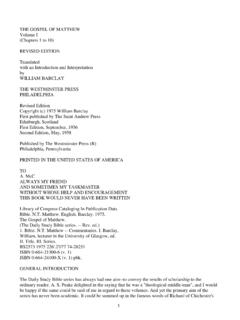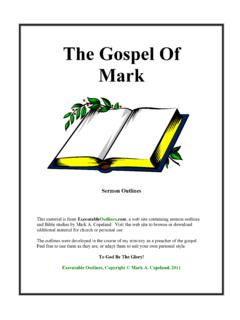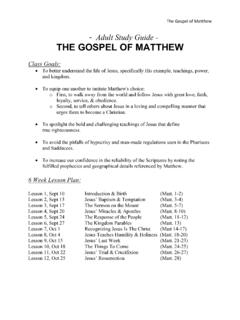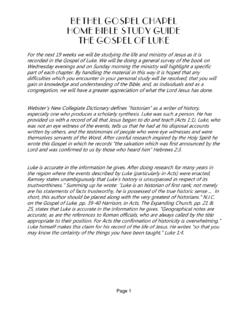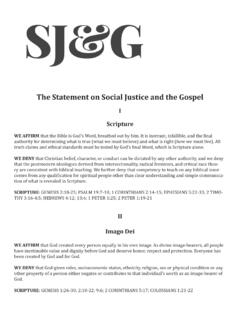Transcription of FIVE LESSONS ON MARKS GOSPEL - ACU Blogs
1 FIVE LESSONS ON MARK S GOSPEL By Tim Randolph !The goal of this presentation is to not only prepare teachers to lead classes through the life and teachings of Jesus but to understand Mark s presentation of Jesus. We will review the standard introductory material for Mark s GOSPEL along with key and distinctive components of Mark s story. Instead of merely presenting the material to the teachers, I wish to make our time more collaborative. A few times during each lesson I will pause and ask a question concerning the material we have covered. This will be indicated in the LESSONS by the letter . You will also see links to short videos to watch together to enhance Qand spark discussion. My hope is that by wrestling with the topics found in Mark, teachers will digest the material and feel adequate to ultimately teach through Mark s GOSPEL .
2 OUTLINE OVERVIEW LESSON 1!"! INTRODUcTiON 1. The beginning of Mark & GOSPEL 2. Mark and the Other Gospels 3. Authorship/Place Of Writing/Date/Audience LESSON 2 - KEY THEmaTic COmPONENTS 1. Kingdom of God 2. Mark is a GOSPEL of action! 3. Mark s use of threefold patterns 4. Irony, Vision and the Unexpected Characters LESSON 3! ! THE CHRiSTOlOGY OF MaRK1. Son of Man or Messiah? 2. Son of God and the Secret LESSON 4! !MaRK S STRUcTURE 1. Drama in three acts ( France) LESSON 5 !!FROm THE UPPER ROOm TO THE RESURREcTiON!1. Brief Synoptic Comparison 2. A Challenge of Discipleship LESSON 1 - INTRODUcTiON The purpose of Lesson 1 is to answer introductory questions regarding the nature of the GOSPEL according to Mark. We will get a feel for where Mark is taking us. I. The beginning of Mark & The GOSPEL A. Mark s story begins The beginning of the good news of Jesus Christ, the Son of God.
3 1 What is a GOSPEL ? What is the good news? Is it limited to Jesus Qcrucifixion and resurrection? Is it significant that Mark places this line at the beginning of his story? Watch this video - If you can, watch the entire video but if there are time constraints watch from minute 1:12 to 8:43. B. Mark begins at Jesus baptism (Read Mark 1:1-12 together) 1. Lacks a birth narrative. a. Moves straight to Jesus ministry. Why would Mark skip to Jesus Ministry? Q II. Mark and the Other Gospels A. Synoptic 1. Means Seeing together a. A new Christian in our congregation was reading the New Testament for the first time. He expressed curiosity by asking me, Why do the gospels sound the same? I swear Tim, this Luke guy is the same person as Mark! Why do you think the canon includes three gospels that share such Q an identical story? 2. Each GOSPEL writer had a different audience.
4 A. matthew is written to display a Jewish Messiah who fulfills the prophecy of the Old Testament. (Read matthew 5:17) b. Luke is written to show Jesus ministry to the Gentiles. (Read the story of Simeon in Luke 2:25-32) c. Mark is written to Gentiles possibly to Rome? (We will discuss this in more detail under III.) !!!!!!!!!!!!!!!!!!!!!!!!!!!!!!!!!!!!!!!! !!!!!!!!!!!!!!!!!1 The HarperCollins Study Bible: New Revised Standard Version, with the Apocryphal/ Deuterocanonical Books, edited by Wayne A. Meeks, (New York: HarperCollins, 1993). All Scripture quotations are from the New Revised Standard Version. B. Who wrote 1st? matthew or Mark? (Handout #1) 1. Traditionally attributed to matthew . St. Augustine believed that matthew wrote first then Mark borrowed from 2. Modern scholarship mostly holds to a Markan priority. Due to Mark s brevity in comparison to the other Gospels and the amount of Markan material found in the other Synoptic writings, the Hypothesis is that matthew and Luke use Mark s narrative.
5 A. Discuss Handout #1. Obviously we are hypothesizing about who wrote first, but what do you Q think? What makes sense? Do you think this matters? III. Authorship/Place Of Writing/Date/Audience A. The Author is never stated in the text. 1. Large works such as Mark were seldom distributed anonymously. A title (the GOSPEL According to Mark) was placed on the text at a very early period of 2. Traditionally attributed to John Mark (read the texts together) a. Acts 12:12. b. Colossians 4:10. c. 1 Peter 5:13 B. It is unknown where Mark wrote his GOSPEL . 1. Possibly Rome, maybe Alexandria or Galilee? Somewhere in the Mediterranean 2. 1 Peter 5:13 locates Mark in Babylon (Rome). C. The dating of Mark is disputed. 1. One internal clue might be found in Mark 13 (Read Mark 13:1-8,14) However, Jesus is speaking apocalyptically referencing the a. Roman Jewish war late 60 s to mid 70 s CE.
6 So possibly written some time !!!!!!!!!!!!!!!!!!!!!!!!!!!!!!!!!!!!!!!! !!!!!!!!!!!!!!!! 2D. A. Carson, Douglas J. Moo. An Introduction to the New Testament. 2nd ed. (Grand Rapids: Zondervan, 2005), 93. 3 Craig S. Keener, The IVP Bible Background Commentary: New Testament, 2nd ed, (Downers Grove, Ill: InterVarsity, 2014), 126. 4 Ibid, 126. 5 Donald Guthrie, New Testament Introduction, 3rd ed, (Downers Grove, Ill: InterVarsity, 1970), 73-74. 6 Joel Marcus, Mark 1-8, Anchor Bible, (New York: Doubleday, 1999), 37-38. D. Audience 1. Likely a Gentile audience possibly the church in Rome? a. Mark fees the need to explain Jewish semantics (Read 3:17; 5:41; 7:11) b. Use of Roman expressions (Read12:42, & 15:16) NEXT LESSON - We will look at a few of Mark s themes. LESSON 2 - KEY THEmaTic COmPONENTS The purpose of Lesson 2 is to highlight key themes and distinctive components in the GOSPEL according to Mark.
7 The goal is to be mindful of the theological devices used by Mark to convey the message of Jesus and to tell his story. (To begin this lesson read Mark chapter 1 in its entirety.) I. The Kingdom of God A. Highlight Mark 1:14-15. What is the Kingdom of God? Q Watch this video together - The video should start at minute 8:30. Jesus scholar Marcus Borg discusses the implications of the Kingdom of God. When you read or hear Kingdom of God, do you think about this term Q having religious/political implications rather than just a personal meaning between God and his people? B. We will address this in more detail in our next lesson - . CHRiSTOlOGY II. Mark is a GOSPEL of action! A. Highlight the use of immediately in the first chapter (v. 12; 18; 20) 1. - Immediately used 41 times by Mark. Used 51 times in the !7 is used 11 times in the first chapter alone!
8 Some translations use At once or without delay . a. Covers a lot of ground in just the first chapter! b. Considerably shorter than the other GOSPEL accounts. B. Mark uses the historical present over 150 times instead of the past This keeps the story vivid and active. !!!!!!!!!!!!!!!!!!!!!!!!!!!!!!!!!!!!!!!! !!!!!!!!!!!!!!!! 7 Joel Marcus, Mark 1-8, Anchor Bible, (New York: Doubleday, 1999), 159. 8 William L. Lane, Commentary on the GOSPEL of Mark, New International Commentary on the New Testament, (Grand Rapids: Eerdmans, 1974), 26. III. Mark s use of threefold patterns9 (Here are a few key examples) A. Three seed parables 1. 4:1-9 The sower 2. 4:26-29 Growing seeds 3. 4:30-32 Mustard seed B. Jesus predicts his death and resurrection three times 1. 8:31 First prediction 2. 9:31 Second prediction 3. 10:33-34 Third prediction C. Peter s Denial 1.
9 14:66-72 D. Jesus announced as Son of God. (Excluding the demoniac confessions) 1. 1:11 Jesus baptism 2. 9:7 The Transfiguration 3. 15:39 The Centurion s confession E. Even Mark s GOSPEL is broken up into three distinct sections. We will look at this in more detail in our 4th lesson MaRK S STRUcTURE . IV. Irony, Vision and Unexpected Characters A. Throughout Mark s GOSPEL those who should see Jesus cannot, while those least expected can see. 1. Jesus family Read 3:20-35 a. Jesus inside teaching b. Family is outside (outside of understanding?) 2. His disciples Read 8:11-33 a. The disciples are confused about the bread v. 16. !!!!!!!!!!!!!!!!!!!!!!!!!!!!!!!!!!!!!!!! !!!!!!!!!!!!!!!! 9 Luke Timothy Johnson, The Writings of the New Testament: An Interpretation, 3rd ed, (Minneapolis: Fortress Press, 2010), 147-8. ! b. Jesus says, Do you have eyes, and fail to see?
10 V. 18 c. Jesus heals the blind man at Bethsaida and he saw everything clearly. v. 25. d. Peter confesses! Does he see? v. 29. e. Jesus predicts his death and Peter rebukes. Peter still doesn t fully see. v. 31-33. 3. The religious Read 1:21-28 a. Those in the synagogue are amazed and confused at Jesus healing power. v. 22, 27. b. A man with an unclean spirit confesses that Jesus is the Holy one of God. v. 24. (More on Jesus request to be quiet in our next lesson.) i. Note that among the religious the Pharisees persistently struggle with blindness. Read 8:10-11. After Jesus multiplies bread for the 4,000 (a sign) the Pharisees ask for a sign. What do you think is the purpose of these stylistic components? Is it ok Q that Mark stylistically structures his story for theological purposes? NEXT LESSON - We will look at Mark s Christology.


